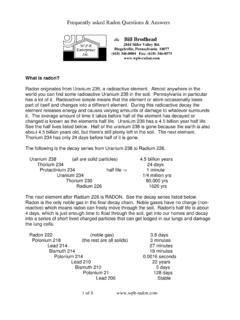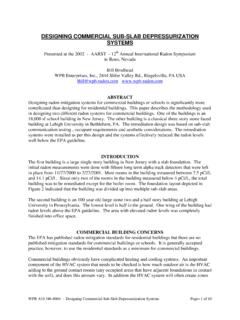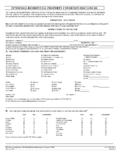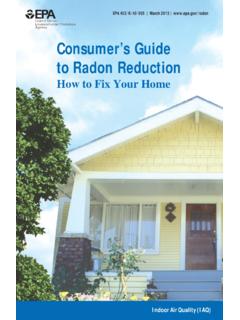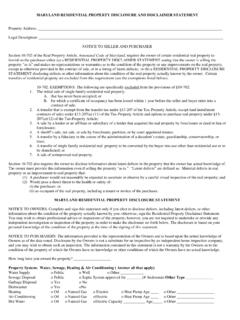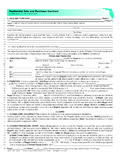Transcription of 2003 International Residential Code for One- and …
1 2003 International Residential code for One- and Two-Family Dwellings Appendix F radon Control Methods 1of 4 Section AF101 SCOPE General. This appendix contains requirements for new construction in jurisdictions where radon -resistant construction is required. Inclusion of this appendix by jurisdictions shall be determined through the use of locally available data or determination of Zone 1 designation in Figure AF101. Section AF102 DEFINITIONS General. For the purpose of these requirements, the terms used shall be defined as follows: SUB-SLAB DEPRESSURIZATION SYSTEM (Passive).
2 A system designed to achieve lower sub-slab air pressure relative to indoor air pressure by use of a vent pipe routed through the conditioned space of a building and connecting the sub-slab area with outdoor air, thereby relying on the convective flow of air upward in the vent to draw air from beneath the slab. SUB-SLAB DEPRESSURIZATION SYSTEM (Active). A system designed to achieve lower sub-slab air pressure relative to indoor air pressure by use of a fan-powered vent drawing air from beneath the slab. DRAIN TILE LOOP. A continuous length of drain tile or perforated pipe extending around all or part of the internal or external perimeter of a basement or crawl space footing. radon GAS. A naturally-occurring, chemically inert, radio-active gas that is not detectable by human senses. As a gas, it can move readily through particles of soil and rock and can accumulate under the slabs and foundations of homes where it can easily enter into the living space through construction cracks and openings.
3 SOIL-GAS-RETARDER. A continuous membrane of 6-mil ( mm) polyethylene or other equivalent material used to retard the flow of soil gases into a building. SUB-MEMBRANE DEPRESSURIZATION SYSTEM. A system designed to achieve lower-sub-membrane air pressure relative to crawl space air pressure by use of a vent drawing air from beneath the soil-gas-retarder membrane. Section AF103 REQUIREMENTS General. The following construction techniques are intended to resist radon entry and prepare the building for post-construction radon mitigation, if necessary (see Figure AF102). These techniques are required in areas where designated by the jurisdiction. 2003 International Residential code for One- and Two-Family Dwellings Appendix F radon Control Methods 2of Subfloor preparation.
4 A layer of gas-permeable material shall be placed under all concrete slabs and other floor systems that directly contact the ground and are within the walls of the living spaces of the building, to facilitate future installations of a sub-slab depressurization system, if needed. The gas-permeable layer shall consist of one of the following: 1. A uniform layer of clean aggregate, a minimum of 4 inches (102 mm) thick. The aggregate shall consist of material that will pass through a 2-inch (51 mm) sieve and be retained by a -inch ( mm) sieve. 2. A uniform layer of sand (native or fill), a minimum of 4 inches (102 mm) thick, overlain by a layer or strips of geotextile drainage matting designed to allow the lateral flow of soil gases. 3. Other materials, systems or floor designs with demonstrated capability to permit depressurization across the entire sub-floor area. Soil-gas-retarder. A minimum 6-mil ( mm) [or 3-mil ( mm) cross-laminated] polyethylene or equivalent flexible sheeting material shall be placed on top of the gas-permeable layer prior to casting the slab or placing the floor assembly to serve as a soil-gas-retarder by bridging any cracks that develop in the slab or floor assembly and to prevent concrete from entering the void spaces in the aggregate base material.
5 The sheeting shall cover the entire floor area with separate sections of sheeting lapped at least 12 inches (305 mm). The sheeting shall fit closely around any pipe, wire or other penetrations of the material. All punctures or tears in the material shall be sealed or covered with additional sheeting. Entry routes. Potential radon entry routes shall be closed in accordance with Sections through Floor openings. Openings around bathtubs, showers, water closets, pipes, wires or other objects that penetrate concrete slabs or other floor assemblies shall be filled with a polyurethane caulk or equivalent sealant applied in accordance with the manufacturer s recommendations. Concrete joints. All control joints, isolation joints, construction joints and any other joints in concrete slabs or between slabs and foundation walls shall be sealed with a caulk or sealant. Gaps and joints shall be cleared of loose material and filled with polyurethane caulk or other elastomeric sealant applied in accordance with the manufacturer s recommendations.
6 Condensate drains. Condensate drains shall be trapped or routed through nonperforated pipe to daylight. Sumps. Sump pits open to soil or serving as the termination point for sub-slab or exterior drain tile loops shall be covered with a gasketed or otherwise sealed lid. Sumps used as the suction point in a sub-slab depressurization system shall have a lid designed to accommodate the vent pipe. Sumps used as a floor drain shall have a lid equipped with a trapped inlet. Foundation walls. Hollow block masonry foundation walls shall be constructed with either a continuous course of solid masonry, one course of masonry grouted solid, or a solid concrete beam at or above finished ground surface to prevent passage of air from the interior of the wall into the living space. Where a brick veneer or other masonry ledge is 2003 International Residential code for One- and Two-Family Dwellings Appendix F radon Control Methods 3of 4 installed, the course immediately below that ledge shall be sealed.
7 Joints, cracks or other openings around all penetrations of both exterior and interior surfaces of masonry block or wood foundation walls below the ground surface shall be filled with polyurethane caulk or equivalent sealant. Penetrations of concrete walls shall be filled. Dampproofing. The exterior surfaces of portions of concrete and masonry block walls below the ground surface shall be dampproofed in accordance with Section R406 of this code . Air-handling units. Air-handling units in crawl spaces shall be sealed to prevent air from being drawn into the unit. Exception: Units with gasketed seams or units that are otherwise sealed by the manufacturer to prevent leakage. Ducts. Ductwork passing through or beneath a slab shall be of seamless material unless the air-handling system is designed to maintain continuous positive pressure within such ducting.
8 Joints in such ductwork shall be sealed to prevent air leakage. Ductwork located in crawl spaces shall have all seams and joints sealed by closure systems in accordance with Section Crawl space floors. Openings around all penetrations through floors above crawl spaces shall be caulked or otherwise filled to prevent air leakage. Crawl space access. Access doors and other openings or penetrations between basements and adjoining crawl spaces shall be closed, gasketed or otherwise filled to prevent air leakage. Passive sub-membrane depressurization system. In buildings with crawl space foundations, the following components of a passive sub-membrane depressurization system shall be installed during construction. Exception: Buildings in which an approved mechanical crawl space ventilation system or other equivalent system is installed. Ventilation. Crawl spaces shall be provided with vents to the exterior of the building.
9 The minimum net area of ventilation openings shall comply with Section of this code . Soil-gas-retarder. The soil in crawl spaces shall be covered with a continuous layer of minimum 6-mil ( mm) polyethylene soil-gas-retarder. The ground cover shall be lapped a minimum of 12 inches (305 mm) at joints and shall extend to all foundation walls enclosing the crawl space area. Vent pipe. A plumbing tee or other approved connection shall be inserted horizontally beneath the sheeting and connected to a 3- or 4-inch-diameter (76 mm or 102 mm) fitting with a vertical vent pipe installed through the sheeting. The vent pipe shall be extended up through the building floors, terminate at least 12 inches (305 mm) above the roof in a location at least 10 feet (3048 mm) away from any window or other opening into the conditioned spaces of the building that is less than 2 feet (610 mm) below the exhaust point, and 10 feet (3048 mm) from any window or other opening in adjoining or adjacent buildings.
10 2003 International Residential code for One- and Two-Family Dwellings Appendix F radon Control Methods 4of 4 Passive sub-slab depressurization system. In basement or slab-on-grade buildings, the following components of a passive sub-slab depressurization system shall be installed during construction. Vent pipe. A minimum 3-inch-diameter (76 mm) ABS, PVC or equivalent gas-tight pipe shall be embedded vertically into the sub-slab aggregate or other permeable material before the slab is cast. A T fitting or equivalent method shall be used to ensure that the pipe opening remains within the sub-slab permeable material. Alternatively, the 3-inch (76 mm) pipe shall be inserted directly into an interior perimeter drain tile loop or through a sealed sump cover where the sump is exposed to the sub-slab aggregate or connected to it through a drainage system.
